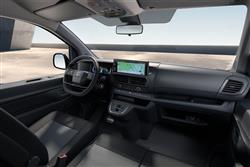CLUB PRO (some text hidden) --NONE--
By Jonathan Crouch
Toyota's Proace Electric gets a facelift and a potentially longer EV drive range. Jonathan Crouch drives it.
Ten Second Reviewword count: 60
Toyota's Proace Electric is the Japanese brand's version of a shared Stellantis Group mid-sized LCV design, but it now comes with a smarter look and a longer driving range from the 75kWh battery. Charging times are competitive and although there's just a single body shape, load area practicality is generally uncompromised by the full-battery powertrain and there's a class-leading warranty.
Backgroundword count: 145
It took Toyota until 2021 to launch an electric vehicle in the UK. Surprisingly, it wasn't a car. And even more surprisingly, it wasn't a Toyota-engineered product either. But the Proace Electric mid-sized van is well worthy of your attention, especially in this updated form. Like a conventional diesel Proace, it shares its design with rival Stellantis Group models. What's on offer here is basically the same as you get with the Citroen e-Dispatch, the Peugeot E-Expert, the Vauxhall Vivaro Electric and the Fiat E-Scudo. We say 'basically the same' because there are some key differences here. On the good side is a 10 year Toyota warranty that embarrasses the 3 year packages you get from this Proace Electric model's cousins. Not so good is the single body height option, but you do get a choice of two battery packs. Let's take a closer look.
Engines and Tech Specword count: 228
Very few Proace Electric customers will be opting for the 50kWh model because this manages just 142 miles between charges. The 75kWh version you're more likely to want now stretches that 217 miles (12 miles further than before). Both figures are of course much the same as those of comparable Stellantis Group models. As usual with an EV van, you can improve these range stats quite considerably if nearly all your driving is urban-based. If you're switching into this EV van from a previous diesel model, there's not too much to get your head around. You turn the key in the ignition, wait for the starting beep, then flick the gear toggle into Drive. There's a drive-mode selector that allows drivers to switch between 'Eco', 'Normal' and 'Power' modes. There's 136hp and 260Nm of torque on tap - though only in 'Power'. The vehicle will always start in its 'Normal' setting and with that engaged, you get just 109hp and 210Nm of pulling power. Get bored of that and switch back to 'Power' and you'll find that 62mph from rest takes 12.1s in the 50kWh version, or 13.3s in the heavier 75kWh model, but either way, top speed is just 80mph. Steering wheel paddles control three levels of brake regeneration, which at its fiercest ploughs extra energy back into the battery, offering more resistance while you're slowing down.
To see the full road test text contact us on 0330 0020 227
Pictures (high res disabled)
.jpg)
.jpg)
|
.jpg)
|

| |||
.jpg)
|
.jpg)
|
.jpg)
| |||

|
Statistics (subset of data only)
Min |
Max |
|
Price: |
£37,762.00 (At 18 Nov 2024, Icon Medium 50kWh ex-VAT) |
£44,633.00 (At 18 Nov 2024, Sport Medium 75kWh ex-VAT) |
Max Speed (mph): |
80 |
|
0-62 mph (s): |
11.9 (75kWh) |
10.8 (75kWh) |
Electric WLTP-Rated Driving Range (miles): |
205 |
|
Length (mm): |
4981 |
|
Width (mm): |
1920 |
|
Height (mm): |
1904 |
|
Braked Towing (kg): |
1000 |
|
Payload Capacity (l): |
1000 |
1253 |
Power (ps): |
136 |
|



